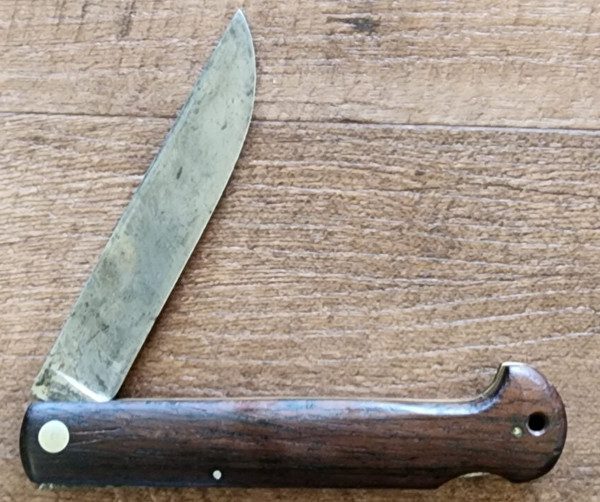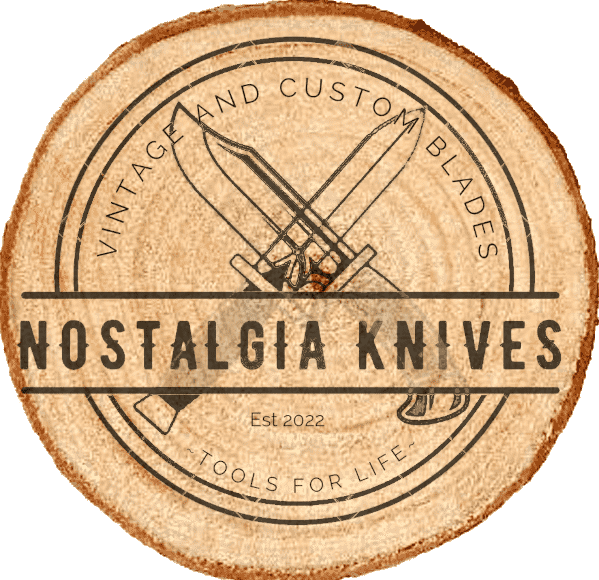Friction Folder Knife – DIY project approach..

A friction folder knife is a versatile and straightforward folding knife design that you can craft with basic tools and materials. In this step-by-step guide, we’ll walk you through the process of making your own friction folder knife. This DIY project is not only rewarding but also allows you to customize the knife to your liking.
All articles are for entertainment purposes only.
Do not take on any DIY project without proper training, or the assistance of a skilled tradesman.
** Remember to beware of your surroundings, and always wear PPE gear
when operating any type of power, pneumatic, or hand tools **
[Gloves, Goggles, Leather Apron, Ventilation, Lighting, Spark Protection, Fire Extinguisher, Etc.]
Materials You May Need:
- Blade Blank Or Forge-able Steel Stock: You can purchase forge-able steel stock. Or a pre-made blade blanks or recycle an old blade from a worn-out knife.
- Handle Material: Choose a durable material for the handle, such as brass, wood, G-10, or Micarta.
- Pins or Rivets: These will be used to secure the blade to the handle.
- Hacksaw: For cutting the blade blank, if applicable.
- Anvil or Hard Surface: For forging, if applicable.
- Bench Grinder or Angle Grinder: For initial shaping.
- Sandpaper (Various Grits): Ranging from coarse to fine for shaping and finishing.
- Files and Rasps: Essential for shaping the handle and fine-tuning details.
- Drill with Bits: To create holes for the pins or rivets.
- Vise or Clamps: To secure the materials while working.
- Colored Paints or Stains: For visual enhancements.
- Etching Acid: Hydrochloric Acid, Nitric Acid, or Sulfuric Acid. Or do a 24hr Vinegar or Coffee soak to show the carbon grain of the steel.
- Epoxy: A strong adhesive for attaching the handle scales to the blade.
- PPE: ‘Personal Protection Equipment’ [IE: Gloves, Goggles, Leather Apron, Ventilation System, Good Lighting, Spark Protection, Accessible Fire Extinguisher, Etc.]
Step 1: Design Your Knife
Before you start crafting, sketch the design of your friction folder knife, investing time in a detailed and thoughtful design will significantly impact the final result. This step involves envisioning the specifics of your knife, from its size and shape to the materials used for liners and spine reinforcement.
- Sketch Your Design:
- Begin by sketching the overall design of your friction folder knife.
- Consider the blade shape, handle length, and the placement of the pivot point.
- Sketch both the open and closed positions to visualize how the knife will function.
- Blade Style and Shape:
- Choose a blade style that aligns with your intended use.
- Options include drop point, clip point, tanto, or spear point.
- Consider the curvature, length, and edge type based on your preferences and the knife’s intended tasks.
- Handle Ergonomics:
- Pay careful attention to the ergonomics of the handle.
- Design it to fit comfortably in your hand, allowing for a secure grip.
- Consider factors such as finger grooves, handle thickness, and overall shape.
- Experiment with different designs to find the one that suits your hand size and grip style.
- Pivot Mechanism:
- Decide on the type of pivot mechanism you want for your friction folder.
- This mechanism relies on friction to keep the blade in place when open, with no locking mechanism.
- Ensure that your design allows for smooth and reliable opening and closing of the knife.
- Materials for Liners and Spine Reinforcement:
- Choose materials for liners and spine reinforcement that enhance the durability and strength of your knife.
- Common choices for liners include materials like stainless steel or titanium, which provide structural support and stability.
- Consider adding spine reinforcement to strengthen the blade, especially if you’re working with a thinner blade profile.
- Decorative Elements:
- Decide if you want to incorporate any decorative elements into your design.
- This could include file-work along the spine, decorative pins, or engraved details on the handle.
- These elements add a personal touch and enhance the visual appeal of the knife.
- Consider Intended Use:
- Keep in mind the primary purpose of your knife.
- Whether it’s for everyday carry, outdoor activities, or specific tasks, the design should align with the knife’s intended use.
- Factors like blade thickness and edge geometry can be tailored to optimize performance for certain tasks.
- Mock-up or 3D Model:
- If possible, create a mock-up or use 3D modeling software to visualize your design in three dimensions.
- This can help you identify any potential issues and make adjustments before moving to the actual crafting phase.
Taking the time to meticulously design your friction folder knife will help ensure that you have a clear road-map for the subsequent steps. It also allows you to make informed decisions about the materials, ergonomics, and functionality, resulting in a well-crafted and functional knife that meets your specific requirements.

